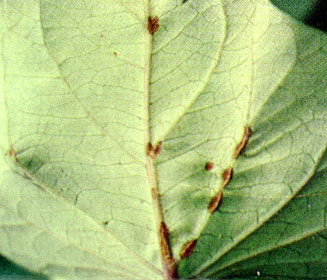|

Cupped, distorted and upright leaves showing the
confluent scabby lesions along veins and petioles (J. O'Sullivan).

Brown,
raised corky lesions on leaf (E. T. Rasco).
|
Diagnostic summary
-
first evident symptoms are small yellowish to reddish
brown spots on the leaves. As the disease advances, spots become corky
outgrowth. Lesions merge and the whole affected tissue develops a
scabby appearance.
-
leaf veins are mostly infected. Affected portions
stop growing, so the leaves curl and become contorted or twisted.
-
lesions on stems may be circular, elongate or flat, depressed or
slightly raised and brownish. Sometimes the borders are distinctly
water-soaked. The lesions become rough and scab-like and can also coalesce
to form larger lesions.
-
young shoots become contorted and twisted. Badly affected plant
parts dry out and die.
|
Taxonomy
Economic
Importance
Geographical
distribution
Symptoms
Morphology
Biology
and ecology
Host
range
Management
References
View
full fact sheet |

